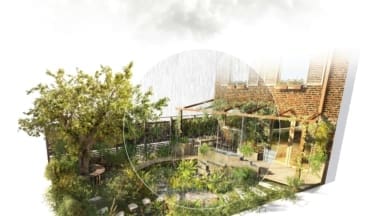
Today, one in four homes are at risk of flooding. As climate change drives increases in extreme weather, the number of properties and gardens at risk is set to increase. According to UK Climate Risk, the number of people in the UK living in areas of significant risk from coastal, river or surface water flooding could double by the 2050s.
Gardens are an important first line of defence to flooding. Properly managed, domestic gardens can channel, absorb and store large quantities of water, which means the risk to buildings and property is mitigated. The risk of localised and downstream flooding is reduced too.
The Flood Resilient Garden is being created by Flood Re, in collaboration with award-winning garden designer Naomi Slade, and Ed Barsley, environmental design expert. Together, they are creating a space that is not only beautiful and habitable, but can also help reduce flood risk.
The Flood Resistant garden is specifically designed to remain habitable for longer in wet weather and recover quicker after periods of heavy rainfall. “This garden helps us see rainwater as a resource rather than a threat. Its design showcases a wide range of practical and affordable measures to slow, store and release rainwater, and make your garden and home more flood resilient. Crucially, it demonstrates that resilience doesn’t have to be a compromise, and can significantly enhance the form and function of your garden and home”, explains Ed Barsley of the The Environmental Design Studio (TEDS).
British households reportedly spent an estimated £18.6 billion on gardens in 2021, of which £1.4 billion on plants. Andy Bord, CEO of Flood Re, commented: “Gardens bring joy to so many of us but they also provide an important first line of defence to flooding. With this garden we’re hoping to inspire more people to think about their flood risk and consider the plants and garden features that will both endure a flood and could also help reduce the physical destruction and psychological distress when a flood strikes. If flood resilient features and water storage capacity were to become a feature of most gardens in a neighbourhood, the positive combined effect would be enormous!”
The Design
The garden rises to the challenges of heavy rain and surface flooding by embracing water as a feature, and harnessing it for later use. It includes dense planting designed to slow the flow, while water is also captured and stored. An elevated deck and mound provide habitable places for insects and wildlife, and well-drained soil for the plants that need it.
The central swale forms a stream, channelling rainwater into a feature pond where it can gradually soak away while large water tanks double as ornamental ponds which store water for later use and – using smart technology – can be discharged ahead of further rain, to create fresh capacity to collect new water. Plants have been carefully chosen for the varied environments within the garden, including a range of pond and bog plants that are well adapted to varying degrees of water inundation.
Naomi Slade, said: “I love creating beautiful gardens that are well-adapted to their situation, and I am thrilled to be designing The Flood Resilient Garden, which will bring a real focus on water to Chelsea next year. In the face of climate change and weather extremes, I hope we can inspire our audience with this message of hope and opportunity.”
The Flood Resistant Garden will be relocated to HR Wallingford, in Oxfordshire.

